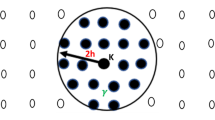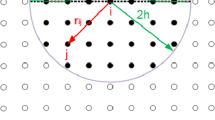Abstract
The utilization of abrasive waterjet (AWJ) cutting/drilling, and in particular its application into hard-to-cut materials, is growing. However, the mechanics of AWJ cutting is complex; the material removal process is not fully understood and, consequently, it has not been accurately modeled. In the current study, work was undertaken to mesh in a first stage the waterflow into the waterjet nozzle in order to use the finite element (FE) method to simulate the pure waterjet flow. The main objective is to investigate and analyze in detail the workpiece material behavior under waterjet impingement; a non-linear FE model (using LS-DYNA 3D code) has been developed, which simulates the erosion of the target material caused by the high-pressure waterjet flow. A combination of Eulerian–Langrangian elements is used for the waterjet and the target material, respectively, in order to handle their interaction. Damaged zones can be localized on impinged materials. Elements’ failure is handled by introducing a threshold strain after which Langrangian elements are removed. The results obtained from this numerical simulation (velocity profile, stress, erosion stages) show a good agreement with the results from previous experimental work that is available in bibliography. The next step of the research will be focused on the simulation of the whole procedure using various abrasives.
Similar content being viewed by others
References
Lemma E, Chen L, Siores E, Wang J (2002) Optimising the AWJ cutting process of ductile materials using nozzle oscillation technique. Int J Mach Tool Manu 42:781–789
Hashish M (1989) A model for abrasive waterjet (AWJ) machining. J Eng Mater Technol 111:155–161
Hashish M (1987) An improved model for erosion by solid particle impact. Proceedings of the Seventh International Conference on Erosion by Liquid and Solid impact ELSI.VII Cambridge, England, pp 66/1–66/9
Momber A, Kovacevic R (1994) Secondary fragmentation in waterjet cutting of brittle multiphase materials. In: Allen N (ed) Waterjet cutting technology. Mechanical Engineering Publications, Ltd., London, England, pp 139–150
Hashish M (1995) Material properties in abrasive waterjet machining. ASME J Eng Ind 117:578–583
Zeng J, Kim T (1996) An erosion model of polycrystalline ceramics in abrasive waterjet cutting. Wear 193:207–217
Zeng J, Kim T (1996) An erosion model for abrasive waterjet milling of polycrystalline ceramics. Wear 199:275–282
Yong Z, Kovacevic R (1997) Simulation of effects of waterjet-mixture film on impact contact in abrasive waterjet machining. Int J Mech Sci 39(6):729–739
Mabrouki T, Raissi K, Cornier A (2000) Numerical simulation and experimental study of the interaction between a pure high-velocity waterjet and targets: contribution to investigate the decoating process. Wear 239:260–273
Mabrouki T, Raissi K (2002) Stripping process modelling: interaction between a moving waterjet and coated target. Int J Mach Tool Manu 42:1247–1258
Momber A, Kovacevic R (1998) Generation of abrasive water jets. Principles of abrasive water jet machining, Springer, Berlin Heidelberg New York, pp 73–74
Ye J, Kovacevic R (1999) Turbulent solid-liquid flow through the nozzle of premixed abrasive waterjet cutting systems. J Eng Manu 213(1):59–67
Author information
Authors and Affiliations
Corresponding author
Rights and permissions
About this article
Cite this article
Maniadaki, K., Kestis, T., Bilalis, N. et al. A finite element-based model for pure waterjet process simulation. Int J Adv Manuf Technol 31, 933–940 (2007). https://doi.org/10.1007/s00170-005-0274-8
Received:
Accepted:
Published:
Issue Date:
DOI: https://doi.org/10.1007/s00170-005-0274-8




